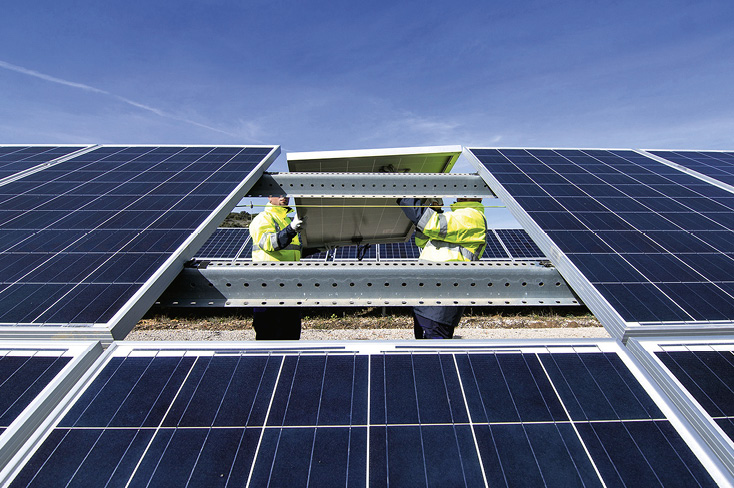From pv magazine 09/2022
When a utility-scale solar site is first connected to the grid, the power purchase agreement (PPA) between the offtaker and developer spells out how much power will be generated, the price for that power, and penalties for non-compliance.
Underperforming systems cause headaches for system operators, and not just because of PPA penalties. There is also lost revenue potential to consider, and with the dramatic reduction in PPA prices over the past 20 years, each lost kilowatt-hour from a legacy PPA is worth several from one signed more recently.
While some gradual production loss is expected, the problem occurs when losses fall beyond the predicted. What causes this? There are two main culprits: module degradation and the lifetime of inverters.
Module degradation
Module degradation is one common reason for discrepancies in energy output. Modeling in the design phase creates a lifetime production curve that is supposed to factor in degradation, typically around 0.5% to 0.7% each year. However, the U.S. Department of Defense (an enormous energy buyer) studied utility-scale solar sites and found that degradation was closer to 1.2% a year.
Not surprisingly, the higher-than-expected degradation came from the oldest systems – those installed in the early to mid-2000s. However, this mismatch can leave system operators on the hook financially for failing to meet their PPA production requirements.

Inverter lifetime
Inverters have a typical lifespan of 10 years, meaning that replacing broken inverters is inevitable for most owner-operators. Say one of your site’s five inverters dies and causes a temporary 20% production loss. If you’re lucky you can find a replacement inverter that can slot in as easily as swapping a bulb.
But as industry veterans know, a number of inverter manufacturers have gone out of business. Furthermore, typical inverter voltage has grown from 600 V to the new standard of 1,500 V in utility-scale systems. Therefore, your original inverters are likely no longer commercially available and may not be easily available even from a manufacturer that’s still in business.
If saddled with outdated inverter technology from defunct companies, it is time-consuming and technically difficult to find a replacement that’s compatible with the existing system. Anyone involved in maintaining solar systems must keep these long-term issues in mind. However, in light of this, a better way to address these issues may be repowering: replacing outdated modules or inverters with newer versions.
The process of deciding whether repowering is a good option can be divided into three steps: First comes analysis of performance data compared to the PPA: Note discrepancies between system performance versus expectations. Flag any particularly troublesome sites or inverters that clearly need replacement. This step sets a baseline of data, but is unlikely to expose more subtle site issues.
Next up is to perform a site inspection and analysis. After an initial review, a site inspection is essential to verify the true conditions of a solar site. Look for common problems such as faulty connections or short circuits. Check for hotspots and do Insulation Resistance (IR) testing. Once you have sufficient data on every site, take this back to the office to analyze potential remedies.
Finally, consider the engineering and financial implications. A thorough analysis of performance data and on-site findings provides a clearer picture of the issues. Nevertheless, some big engineering and financial questions remain: Is this a simple swap of one inverter, or a system-wide rewiring? How far from the PPA curve is actual production? Any proposed repowering plan should come with a financial model including the IRR, ROI, and an updated levelized cost of energy, to determine if the fix is worth the cost. If the scope of work and finances line up, then it’s time to procure equipment and update the system.
Going through the repowering process is a further cost on top of the original investment, but it can pencil out if it will avoid PPA penalties and restore revenues. It’s certain to become more common in the industry as systems deteriorate and require more upkeep.
Meanwhile, site operators should consider how equipment procurement and preventative measures now can avoid supply chain issues and bigger disruptions – and costs – down the road. 
About the authors
Chris Chappell is the senior director of global engineering services and Stephen Shirey is the senior director of storage and power electronics at Clean Energy Associates, an Intertek company.
This content is protected by copyright and may not be reused. If you want to cooperate with us and would like to reuse some of our content, please contact: editors@pv-magazine.com.



1 comment
By submitting this form you agree to pv magazine using your data for the purposes of publishing your comment.
Your personal data will only be disclosed or otherwise transmitted to third parties for the purposes of spam filtering or if this is necessary for technical maintenance of the website. Any other transfer to third parties will not take place unless this is justified on the basis of applicable data protection regulations or if pv magazine is legally obliged to do so.
You may revoke this consent at any time with effect for the future, in which case your personal data will be deleted immediately. Otherwise, your data will be deleted if pv magazine has processed your request or the purpose of data storage is fulfilled.
Further information on data privacy can be found in our Data Protection Policy.